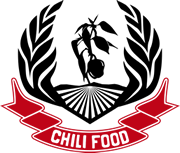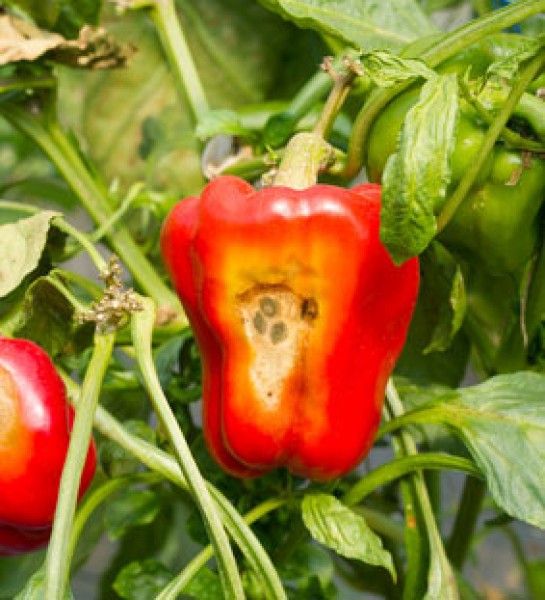
Chili Pepper Diseases
First of all: most chili pepper diseases can be avoided by a good care and the right location for your chili plants. Use a good, new substrate that has been treated thermally, especially for pot and in-door plants. Place the plants in a sheltered, but very warm and sunny place. Make sure that water can drain away easily, as chillies should not be left in standing water. Besides, there are not only harmful fungi and bacteria but also good ones. Therefore, fertilizers containing a portion of soil-improving bacteria and mycorrhiza-fungi can strengthen your chili pepper plants and displace unwelcome fungi and bacteria.
And if, despite all prevention, a disease occurs then you will find in the following the pictures for identifying the diseaese as well as tipps for protective and counter-measures:
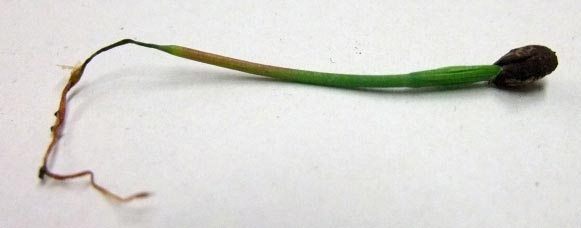 Disease pattern: Damping off is caused by a number of different pathogens (fungi) that attack seedlings and young plants. If the fungus attacks the roots, the seedling wilts, if it attacks the stem, it becomes thin and gets stem lesions at ground level, so that it falls. Often the seed leaves show small round gray spots with black dots.
Disease pattern: Damping off is caused by a number of different pathogens (fungi) that attack seedlings and young plants. If the fungus attacks the roots, the seedling wilts, if it attacks the stem, it becomes thin and gets stem lesions at ground level, so that it falls. Often the seed leaves show small round gray spots with black dots.
Prevention: Since the disease usually sits on the seeds, it helps to soak seeds before sowing (in chamomile tea or a herbal soup of garlic, horsetail, valerian or horseradish). Do not plant seeds too closely and dont water too frequently. Ensure good air circulation. Use a good, thermally treated substrate.
Treatment: None. Immediately remove the affected plants with roots and soil so that the fungus cannot spread any further.
Image source: Wikipedia, INAKAvillage211
 Disease pattern: Anthracnose is caused by a fungus and affects especially the fruits. Infected plants develop dark, water soaked lesions on fruits, often with dark rings. The leaves may also be affected and form brown, dry spots and crumble. The spores penetrate the plant through injuries.
Disease pattern: Anthracnose is caused by a fungus and affects especially the fruits. Infected plants develop dark, water soaked lesions on fruits, often with dark rings. The leaves may also be affected and form brown, dry spots and crumble. The spores penetrate the plant through injuries.
Prevention: The fungal disease is promoted by cool wet weather. Pour your plants in the morning, so that they do not have moist leaves overnight. Good ventilation is helpful in the greenhouse. Ensure a varied crop rotation in the garden. Since the fungal spores can already be towed with the seed, it is helpful to soak the seeds in chamomile tea.
Treatment: The use of fungicides has to be weighed, probably it is better to simply remove and destroy the affected plants. Do not compost infected leaves, fruit or stems and thoroughly clean up garden areas in the fall, after harvest, to reduce over wintering sites for the fungal spores.
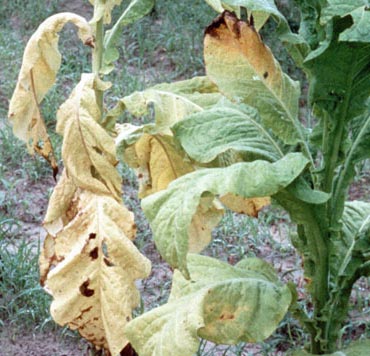 Disease pattern: First symptom is often a partially wilting of the leaves while other parts of the plant stay healthy. Then, the leaves get a rusty brown or yellow colour. The wilting of the leaves occurs, in particular, when there is strong irradiation, and the plant may seem to recover in the dark. Fusarium enters through the roots of the plants and the organism blocks vessels in the cells. Once blocked, the cells cannot transport water and nutrients to the plant.
Disease pattern: First symptom is often a partially wilting of the leaves while other parts of the plant stay healthy. Then, the leaves get a rusty brown or yellow colour. The wilting of the leaves occurs, in particular, when there is strong irradiation, and the plant may seem to recover in the dark. Fusarium enters through the roots of the plants and the organism blocks vessels in the cells. Once blocked, the cells cannot transport water and nutrients to the plant.
Prevention: Since the Fusarium is most prevalent in warm climates and in residential or greenhouse plants, ensure good ventilation. Use new, good soil and remove all old plant debris annually (not into the compost). The best way to prevent infection in your plants is rotation and sterilization. Never plant the same crop in the same place annually.
Treatment: If only a few leaves are affected, remove them (do not put into the compost!) and replace the soil. You should remove strongly infected plants completely (including soil) so that they do not infect the other plants. There is no chemical plant protection against this fungus.
Image source: Wikipedia, R.J. Reynolds Tobacco Company Slide Set
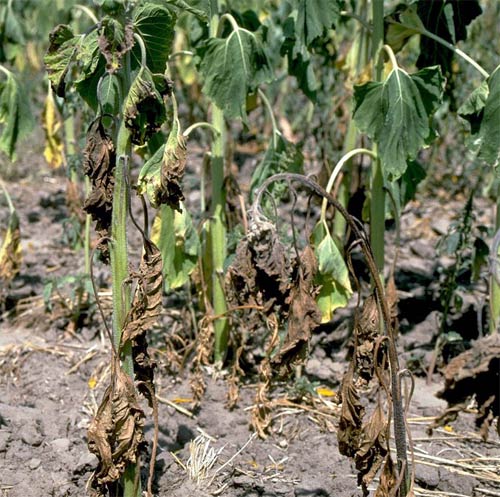 Disease pattern: Sudden slack or wilted leaves in the middle of the growth phase, often at high temperatures and water deficiency, which makes the identification not easier. The difference is that in the case of water stress usually all leaves wither, in the case of fungal attack, the oldest leaves of the plant wilt - i.e. a stepwise appearance of the wilt is characteristic. In the case of perennial plants Verticillium wilt can be detected by scratching the bark of the wood with a knife. If the vessels are browned, the plant is attacked by verticillium fungus. The fungus enters through the roots into the plant and blocks the vessels, but it spreads relatively slowly and usually only affects individual leaves and stems.
Disease pattern: Sudden slack or wilted leaves in the middle of the growth phase, often at high temperatures and water deficiency, which makes the identification not easier. The difference is that in the case of water stress usually all leaves wither, in the case of fungal attack, the oldest leaves of the plant wilt - i.e. a stepwise appearance of the wilt is characteristic. In the case of perennial plants Verticillium wilt can be detected by scratching the bark of the wood with a knife. If the vessels are browned, the plant is attacked by verticillium fungus. The fungus enters through the roots into the plant and blocks the vessels, but it spreads relatively slowly and usually only affects individual leaves and stems.
Prevention: Use a healthy, thermally treated soil. Soak seeds in chamomile tea or herb soup of garlic, horsetail, valerian or horseradish. The best way to prevent infection in your plants is rotation and sterilization. Never plant the same crop in the same place annually. Avoid water stress through pouring regularly, but avoid dammed-up water.
Treatment: Verticillium wilt can`t be cured once it enters the plant. It`s best to remove and destroy small or one-year plants (do not put into the compost!). The disease remains in the soil after you remove the plant, so don`t plant another susceptible species in the same area. In the case of perennial plants, the plant must be cut back into healthy wood and all the withered leaves removed and littered or burned.
Image source: Wikipedia, Howard F. Schwartz, Colorado State University, Bugwood.org
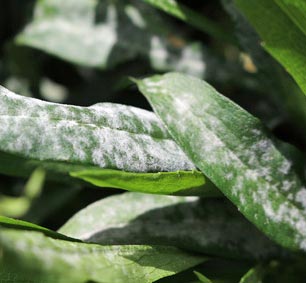 Disease pattern: Mildew is actually known from roses, but the powdery mildew can infect most of the plant species. The Powdery Mildew fungus covers the leaves with a floury layer and penetrates into the plant. It usually covers the upper part of the leaves and affects the older leaves first; the leaves turn yellow and dry out. Later the fungus causes some leaves, buds and growing tips to twist, break, or become distorted. The growth of the powdery mildew is favored by dry and warm weather with nighttime dew.
Disease pattern: Mildew is actually known from roses, but the powdery mildew can infect most of the plant species. The Powdery Mildew fungus covers the leaves with a floury layer and penetrates into the plant. It usually covers the upper part of the leaves and affects the older leaves first; the leaves turn yellow and dry out. Later the fungus causes some leaves, buds and growing tips to twist, break, or become distorted. The growth of the powdery mildew is favored by dry and warm weather with nighttime dew.
The downy mildew appears as yellow to white patches on the upper surfaces of older leaves. On the undersides, these areas are spreaded with white to grayish covers. The downy mildew favours cool, moist weather in early spring or late autumn.
Prevention: Powdery mildew thrives in hot and humid weather, so avoid overhead watering to reduce humidity. Avoid over-fertilization and overcrowded areas and increase air circulation; this also helps to reduce humidity. A home remedy is milk: Mix 1 part of milk with 9 parts of water and spray the plants 2-3 times a week. Use fresh milk, and no UHT milk! The lecithin of the milk inhibits the fungus and the sodium phosphate strengthens the plant. The fungus also doesnt like some herbs: plant chervil, chives, basil or garlic between your chili plants. The fertilization with plant soups from garlic, onion, horsetail, yarrow and / or tans has also proven to be successful.
Treatment: Remove and destroy all infected leaves (do not put on the compost!). A home remedy is spraying the plants with a liquid of garlic or horsetail. In the next 2 - 3 years, a change in the crop rotation is useful, so that the fungus regresses in the soil. Various plant protection products on the basis of sulfur may also be helpful. But you should carefully weigh the benefit of using chemical controls, since beneficial insects are often harmed. A beneficial insect to mildew is e.g. the earworm that grazes the mildew lawns.
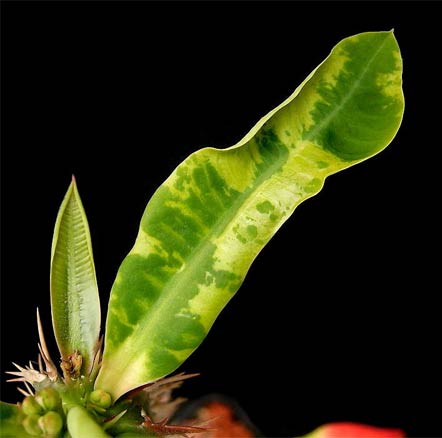 Disease pattern: The tobacco mosaic virus not only affects tobacco plants, but nightshade plants in general, including many chillies and pepper plants. The virus is extremely contagious and can be transmitted after touching a cigarette. Smokers should always wash hands before touching the chili pepper plants. The disease can be identified by mottled light-green-yellow spots on the leaves, which become irregular and patchy (mosaic-shaped) over the leaf and which later brown. Young leaves cripple or twist. Also the fruits dwarf and get stains.
Disease pattern: The tobacco mosaic virus not only affects tobacco plants, but nightshade plants in general, including many chillies and pepper plants. The virus is extremely contagious and can be transmitted after touching a cigarette. Smokers should always wash hands before touching the chili pepper plants. The disease can be identified by mottled light-green-yellow spots on the leaves, which become irregular and patchy (mosaic-shaped) over the leaf and which later brown. Young leaves cripple or twist. Also the fruits dwarf and get stains.
Prevention: Use resistant varieties (mainly for vegetable bell peppers). In the case of chili plantations, attention is paid to a meticulous separation of the fields from tobacco plants. As aphids also transmit the virus, you should use some pest control measures.
Treatment: Remove the affected plants immediately and destroy them (do not put into the compost!).
Image source: Wikipedia, Frank Vincentz
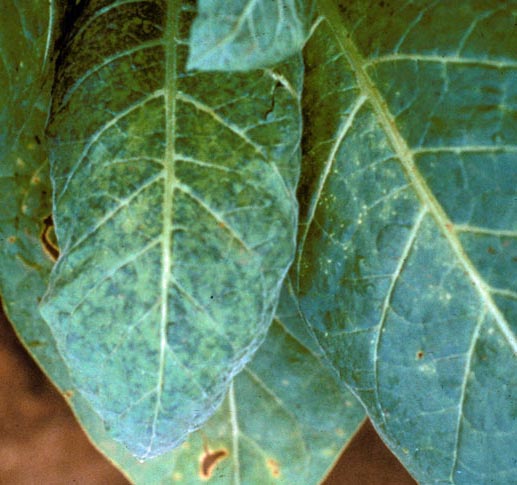 Disease pattern: This virus is a widespread virus for chili pepper plants, it affects most species of the nightshade family. The leaves get yellow, mosaic spots while the ribs remain green and then wither / finally dry. In the advanced stage, the fruits also cover mosaic-shaped spots. Fruit growth is generally reduced, and often fruits have a mosaic pattern or deformations.
Disease pattern: This virus is a widespread virus for chili pepper plants, it affects most species of the nightshade family. The leaves get yellow, mosaic spots while the ribs remain green and then wither / finally dry. In the advanced stage, the fruits also cover mosaic-shaped spots. Fruit growth is generally reduced, and often fruits have a mosaic pattern or deformations.
Prevention: Since the virus is transmitted by aphids (mainly the green peach aphid), an early aphid control is recommended. Also, you should plant your chili plants far away from potatoes as these are the original hosts of the virus. If you have used gardening tools with infected plants, disinfect them.
Treatment: None. Immediately remove any contaminated plants and destroy or burn them (do not put into the compost!).
Image source: R.J. Reynolds Tobacco Company Slide Set, R.J. Reynolds Tobacco Company, Bugwood.org - Creative Commons License, licensed under a Creative Commons Attribution 3.0 License.
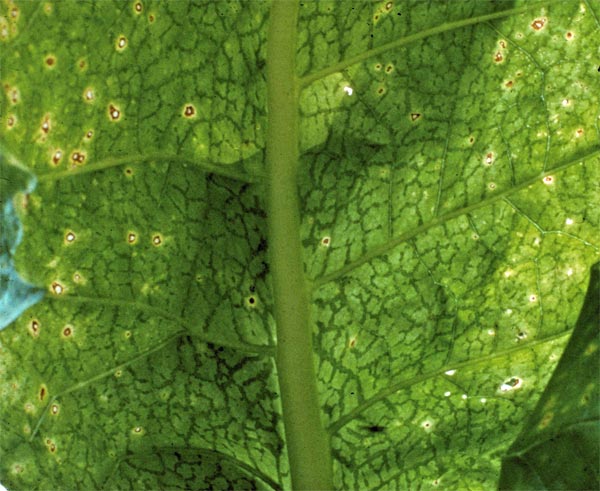 Disease pattern: This virus is a widespread virus for chili pepper plants, it affects most species of the nightshade family. The leaves get yellow, mosaic spots while the ribs remain green and then wither and finally dry up. In the advanced stage, the fruits are also covered mottled patches. Fruit growth is generally reduced, and often fruits have a mosaic pattern or deformations.
Disease pattern: This virus is a widespread virus for chili pepper plants, it affects most species of the nightshade family. The leaves get yellow, mosaic spots while the ribs remain green and then wither and finally dry up. In the advanced stage, the fruits are also covered mottled patches. Fruit growth is generally reduced, and often fruits have a mosaic pattern or deformations.
Prevention: Since the virus is transmitted by aphids (mainly the green peach aphid), an early aphid control is recommended. Also, you should plant your chili plants far away from potatoes and tomatoes as these are the original hosts of the virus. If you have used gardening tools with infected plants, disinfect them.
Treatment: None. Immediately remove any contaminated plants and destroy or burn them (do not put into the compost!).
Image source: Wikipedia, R.J. Reynolds Tobacco Company Slide Set
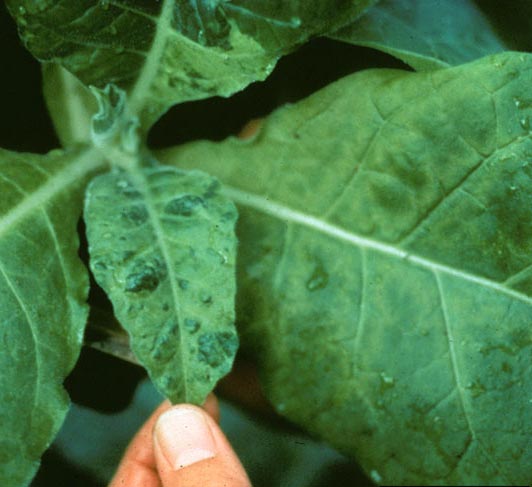 Disease pattern: The cucumber mosaic virus is one of the most common viruses that can attack chili pepper plants. There are different strains of virus that can produce slightly different symptoms but can affect all chillies. The symptoms are strongly dependent on the age of the plant at the outbreak of the disease and are very similar to the tobacco mosaic virus. One of the most common symptoms is a severely stunted, nonproductive plant that has dull light green foliage with a leathery appearance but not distinctive foliar markings. In some cases the leaves become narrow, while in other cases, small ring spots are found on the leaves.
Disease pattern: The cucumber mosaic virus is one of the most common viruses that can attack chili pepper plants. There are different strains of virus that can produce slightly different symptoms but can affect all chillies. The symptoms are strongly dependent on the age of the plant at the outbreak of the disease and are very similar to the tobacco mosaic virus. One of the most common symptoms is a severely stunted, nonproductive plant that has dull light green foliage with a leathery appearance but not distinctive foliar markings. In some cases the leaves become narrow, while in other cases, small ring spots are found on the leaves.
Prevention: The CMV affects many different plants, including many weeds and is transmitted by aphids. Therefore, keep your chili plants weed and aphid-free, or use resistant varieties.
Treatment: None. Immediately remove any contaminated plants and destroy or burn them (do not put into the compost!).
Image source: R.J. Reynolds Tobacco Company Slide Set, R.J. Reynolds Tobacco Company, Bugwood.org
Youll find another informative foto here: http://www.forestryimages.org/browse/detail.cfm?imgnum=5266084
The Chile Pepper Institute offers a very detailed list of all chili and bell pepper diseases with pictures: https://cpi.nmsu.edu/diseases-disorders-insects-the-chile-pepper-institute/ and http://aces.nmsu.edu/pubs/_circulars/circ549.html
Manufacturer
Name: | Chili-Food-Wissen |
Address: |
